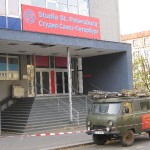
The statue pictured on the left here, is an extremely rare sight in the present-day Czech Republic. It stands in Námestí Interbrigády, a large square on one side of Jugoslávských partyzánu, the main thoroughfare leading from our nearest Metro station at Dejvická to Podbaba where we live. The reason that it is such a rare sight is because it portrays a Marshall of the Soviet Red Army, Ivan Stepanovich Konev.
As you can probably imagine, following the Velvet Revolution at the end of 1989, steps were rapidly taken to rid Czechoslovakia, (since 1st January 1993, the Czech Republic and Slovakia), of anything that celebrated the preceding nearly 42 years of Soviet imposed communist rule. Anything that was part of the so called ‘normalisation’ that followed the crushing of the Prague Spring of 1968 by the Soviet Red Army was particularly detested.
Therefore, not many weeks after the Velvet Revolution, 14 Metro stations which bore names to supposedly celebrate Soviet-Czech friendship, were re-named. Thus Moskevská (Moscow Station) became Andel (Angel) and Leninova became Dejvická. Most poignantly, Red Army Square in the centre of Prague was re-named Jan Palach Square to commemorate the self-immolator whose death became such a focus for those who opposed communist oppression.
However, the statue of Marshall Konev remains, simply because he just pre-dates the Communist coup of 1948. For it was he who led the troops of the Soviet Red Army that liberated Prague from Nazi oppression, entering the city on 9th May 1945, a few hours after the German unconditional surrender across Europe had come into force. The sixty-fifth anniversary of these events occurred just over two weeks ago, hence the floral tributes lying at the foot of the statue when I took the picture a few days later.

All around Prague there are quite a number of memorials on buildings similar to these ones illustrated here. On 5th May 1945, there began an uprising by Prague citizens against the Nazi occupying forces. Those involved in the uprising expected that the US Third Army under General Patton, which was advancing from the west, would soon come to their aid. What they did not know was that a previous agreement between the US and Soviet governments, only allowed for American troops to advance as far as a line linking Karlovy Vary – Plzen – Ceske Budejovice.
The Soviet government insisted that this agreement be honoured. Thus, many Prague citizens commemorated on these plaques lost their lives because the Soviet Red Army advancing from the east took 24-48 hours longer to reach Prague than US troops from the west would have done if they had been allowed to do so. Eventually, the Nazi forces withdrew westwards, keen to surrender to the American rather than the Soviet authorities. They knew who would treat them better! And because of their withdrawal, relatively little damage was done to physical structure of Prague itself, leaving it with the multiplicity of architectural gems that continue today to delight the eye of resident and visitor alike.




